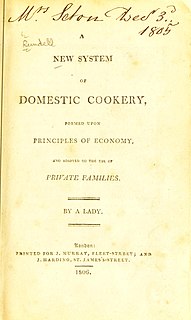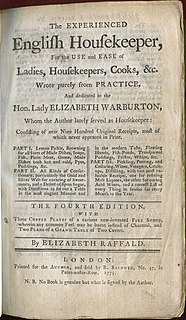
Marmalade is a fruit preserve made from the juice and peel of citrus fruits boiled with sugar and water. The well-known version is made from bitter orange, but it is also made from lemons, limes, grapefruits, mandarins, sweet oranges, bergamots, and other citrus fruits, or a combination. Citrus is the most typical choice of fruit for a marmalade, though historically the term has often been used for non-citrus preserves.

Christmas pudding is a type of pudding traditionally served as part of the Christmas dinner in Britain, Ireland and in other countries where it has been brought by British and Irish immigrants. It has its origins in medieval England, and is sometimes known as plum pudding or just "pud", though this can also refer to other kinds of boiled pudding involving dried fruit. Despite the name "plum pudding", the pudding contains no actual plums due to the pre-Victorian use of the word "plums" as a term for raisins. The pudding has been heavily mythologized, including the erroneous idea that it is traditionally composed of thirteen ingredients, symbolizing Jesus and the Twelve Apostles, or that it was invented by George I. Early recipes include little more than suet, dried fruit, breadcrumbs, flour, eggs and spice, along with liquid which may be milk or fortified wine. Later recipes became more elaborate.

Toad in the hole or Sausage Toad is a traditional English dish consisting of sausages in Yorkshire pudding batter, usually served with onion gravy and vegetables. Historically, the dish has also been prepared using other meats, such as rump steak and lamb's kidney.

The book best known as Mrs Beeton's Book of Household Management, also published as Mrs Beeton's Cookery Book, is an extensive guide to running a household in Victorian Britain, edited by Isabella Beeton and first published as a book in 1861. Previously published in parts, it initially and briefly bore the title Beeton's Book of Household Management, as one of the series of guide-books published by her husband, Samuel Beeton. The recipes were highly structured, in contrast to those in earlier cookbooks. It was illustrated with many monochrome and colour plates.

Eliza Acton was an English food writer and poet who produced one of Britain's first cookery books aimed at the domestic reader, Modern Cookery for Private Families. The book introduced the now-universal practice of listing ingredients and giving suggested cooking times for each recipe. It included the first recipes in English for Brussels sprouts and for spaghetti. It also contains the first recipe for what Acton called "Christmas pudding"; the dish was normally called plum pudding, recipes for which had appeared previously, although Acton was the first to put the name and recipe together.

The Art of Cookery Made Plain and Easy is a cookbook by Hannah Glasse (1708–1770) first published in 1747. It was a bestseller for a century after its first publication, dominating the English-speaking market and making Glasse one of the most famous cookbook authors of her time. The book ran through at least 40 editions, many of which were copied without explicit author consent. It was published in Dublin from 1748, and in America from 1805.
Salmagundi is a dish of seasoned meats, stewed with vegetables.

An apple dumpling is a baked or boiled pastry-wrapped apple. To prepare apple dumplings, apples are peeled, cored and sometimes quartered and placed on a portion of dough. The hole from the core may be filled with cinnamon, butter and sugar and sometimes dried fruit such as raisins, sultanas, or currants. The dough is folded over the apples and sealed. Sometimes a spiced sauce is poured over the dumplings which are then baked until tender; the sugar and butter create a sweet sauce. Apple dumplings can be served hot, cold, or room temperature for breakfast, dessert, or as a main dish.

Steak and kidney pudding is a traditional British main course in which stewed beef steak and ox kidney is enclosed in suet pastry and slow steamed on a stove top.

The Compleat Housewife, or, Accomplish'd Gentlewoman's Companion is a cookery book written by Eliza Smith and first published in London in 1727. It became extremely popular, running through 18 editions in fifty years.
A suet pudding is a boiled, steamed or baked pudding made with wheat flour and suet, often with breadcrumb, dried fruits such as raisins, other preserved fruits, and spices. The British term pudding usually refers to a dessert or sweet course, but suet puddings may be savoury.

Sussex pond pudding, or well pudding, is a traditional English pudding from the southern traditional county of Sussex. It is made of a suet pastry, filled with butter and sugar, and is boiled or steamed for several hours. Modern versions of the recipe often include a whole lemon enclosed in the pastry. The dish is first recorded in Hannah Woolley's 1672 book The Queen-Like Closet.

Bread and butter pudding is a traditional bread pudding popular in British cuisine. Slices of buttered bread scattered with raisins are layered in an oven dish, covered with an egg custard mixture seasoned with nutmeg, vanilla or other spices, then baked.

A New System of Domestic Cookery, first published in 1806 by Maria Rundell, was the most popular English cookbook of the first half of the nineteenth century; it is often referred to simply as "Mrs Rundell", but its full title is A New System of Domestic Cookery: Formed Upon Principles of Economy; and Adapted to the Use of Private Families.

The Accomplisht Cook is an English cookery book published by the Restoration era professional cook Robert May in 1660, and the first to group recipes logically into sections.

Maria Eliza Rundell was an English writer. Little is known about most of her life, but in 1805, when she was over 60, she sent an unedited collection of recipes and household advice to John Murray, of whose family—owners of the John Murray publishing house—she was a friend. She asked for, and expected, no payment or royalties.

The Experienced English Housekeeper is a cookery book by the English businesswoman Elizabeth Raffald (1733–1781). It was first published in 1769, and went through 13 authorised editions and at least 23 pirated ones.

Modern Cookery for Private Families is an English cookery book by Eliza Acton. It was first published by Longmans in 1845, and was a best-seller, running through 13 editions by 1853, though its sales were later overtaken by Mrs Beeton. On the strength of the book, Delia Smith called Acton "the best writer of recipes in the English language", while Elizabeth David wondered why "this peerless writer" had been eclipsed by such inferior and inexperienced imitators.

The Queen-like Closet, Or, Rich Cabinet was a cookery book published in 1670 by the English writer on household management, Hannah Woolley. It ran through five English editions by 1684. At least two German editions were also printed.


















